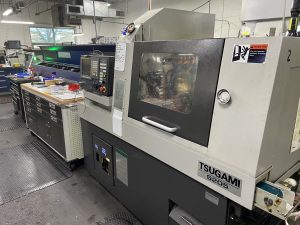

Swiss Turning vs. Traditional Turning: Which Process Fits Your Needs?
When it comes to precision machining, choosing the right turning method is essential for the success of any project. Both Swiss turning and traditional turning offer distinct benefits, tailored to different applications. In this article, we’ll explore the key differences between these two machining techniques to help you decide which one aligns best with your project goals.
Gaining Insight Into Traditional Turning
Traditional turning is a widely-used machining process where a stationary cutting tool removes material from a rotating workpiece. It's incredibly versatile and often employed for creating everything from simple shafts to more complex components. While it may not be the first choice for every project, traditional turning has proven its worth across numerous industries.
The Strengths of Traditional Turning
- Versatility: This method can handle a broad spectrum of materials and part sizes, making it suitable for a variety of applications.
- Cost Efficiency: For larger, less intricate parts, traditional turning offers a cost-effective solution.
- Simplified Setup: With fewer variables involved, traditional turning setups tend to be quicker, especially for straightforward tasks.
The Challenges of Traditional Turning
- Accuracy: The level of precision achieved might not meet the stringent requirements of highly detailed parts.
- Complexity: When dealing with small, intricate components, traditional turning may not provide the flexibility needed to deliver optimal results.
Diving Deep into Swiss Turning
Swiss turning, also referred to as Swiss machining, uses a guide bushing to stabilize the workpiece during the cutting process. This approach excels in producing small, high-precision parts with complex geometries. Its unique design makes it a go-to option for many manufacturers looking for unmatched accuracy.
The Benefits of Swiss Turning
- Exceptional Precision: Swiss turning delivers tight tolerances and superior surface finishes, making it ideal for delicate parts.
- Intricate Designs: It handles the machining of intricate features on small parts with ease and efficiency.
- Time-Saving: Many Swiss machines can complete parts in a single operation, significantly reducing production time.
Swiss Turning Limitations
- Initial Costs: Specialized equipment and tools can drive up the upfront investment required for Swiss turning.
- Size Restrictions: This method works best with smaller diameter workpieces, limiting its application for larger parts.
Key Distinctions Between Swiss Turning and Traditional Turning
Accuracy and Tolerance Levels
- Swiss Turning: Delivers outstanding precision, perfect for parts needing extremely tight tolerances.
- Traditional Turning: Suitable for projects where high precision isn’t a top priority.
Part Complexity
- Swiss Turning: Easily manages parts with multiple features and complex designs.
- Traditional Turning: Best suited for simpler parts with fewer intricate details.
Production Volumes
- Swiss Turning: More efficient for high-volume production of small, complex parts.
- Traditional Turning: Cost-effective for lower-volume runs or larger parts.
Material Handling
- Swiss Turning: Performs exceptionally well with challenging materials due to its stability.
- Traditional Turning: Works adequately with common materials and standard machining tasks.
Making the Right Choice for Your Project
Situations Favoring Swiss Turning
- Creating small, intricate parts with tight tolerances.
- High-volume production runs demanding consistent precision.
- Components with a high length-to-diameter ratio.
Situations Favoring Traditional Turning
- Machining larger, less complex parts.
- Projects with limited budgets and less stringent precision requirements.
- Low to medium production volumes.
How Machining Concepts Can Support You
At Machining Concepts, we’re experts in both Swiss turning and traditional turning methods. Our skilled machinists leverage advanced machinery to cater to the diverse needs of your projects.
- Professional Guidance: Our team will assist you in determining the most appropriate turning method based on your project specifications.
- Quality Assurance: We ensure your parts meet all necessary standards with our unwavering commitment to quality.
- Timely Deliveries: Our streamlined processes guarantee your project stays on schedule.
Final Thoughts
Deciding between Swiss turning and traditional turning depends on several factors, such as part complexity, precision demands, and production volume. By understanding the merits of each technique, you can make an informed choice that best suits your project’s requirements.
Ready to take the next step? Get in touch with Machining Concepts today to discuss your machining needs and find out how our comprehensive services can help bring your project to life.
*Additional note: Whether you're working on prototypes or full-scale production runs, our dedicated team is here to support you every step of the way.*
Door Handle On Rosette
Door Handle On Rosette,Brushed Lever Door Handle,Front Lever Door Handle,Fancy Solid Lever Door Handle
Wenzhou Shenghong Metal Products Co.,Ltd , https://www.shenghonglock.com

